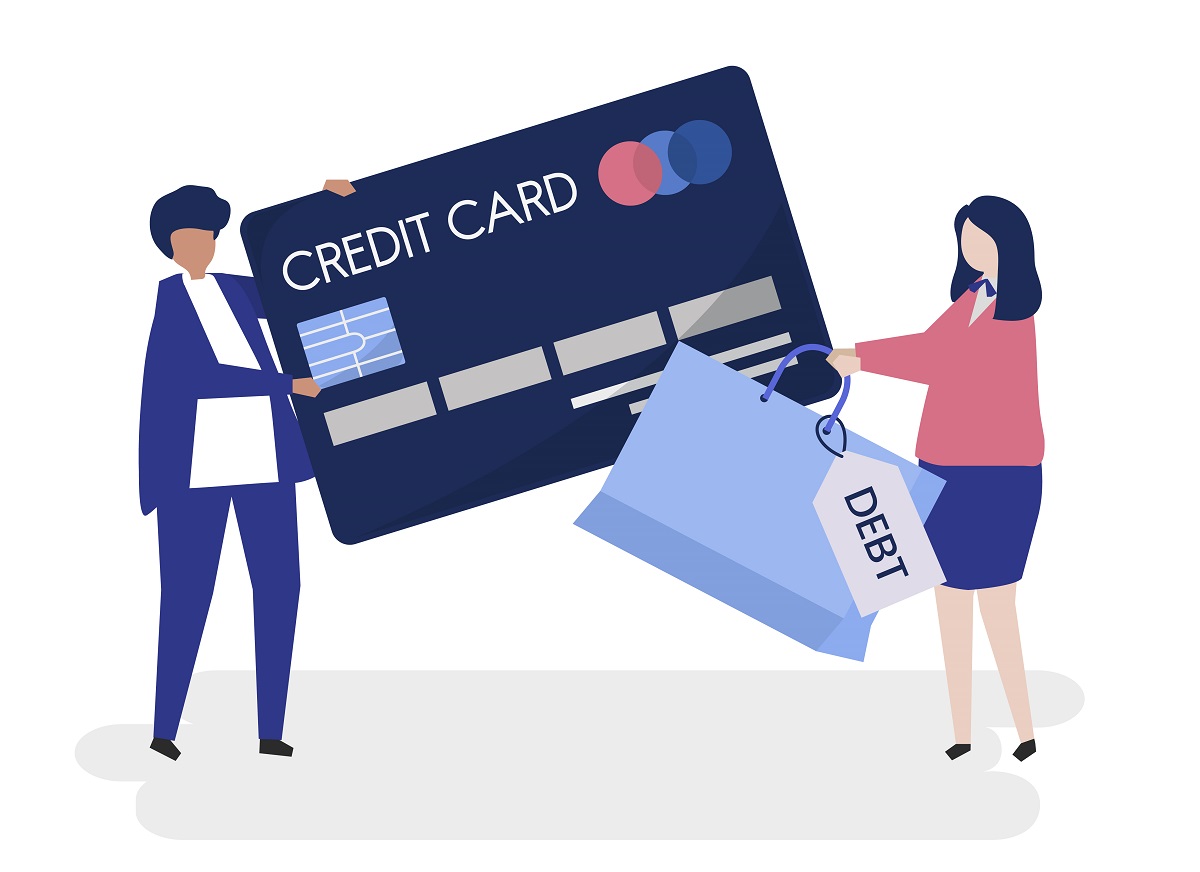
|
|
You might be using an unsupported or outdated browser. To get the best possible experience please use the latest version of Chrome, Firefox, Safari, or Microsoft Edge to view this website. |

If you’re in credit card debt, first things first. Take a deep breath. You are not alone.
According to the Consumer Financial Protection Bureau, Americans have about $1 trillion in credit card debt. Borrowers have paid $104 billion in interest in the past year alone.
In this article we’ll cover the two popular ways to tackle credit card debt–the debt snowball and the debt avalanche. They boil down to two schools of thought. One relies on psychology as a motivator (debt snowball) and the other focuses just on the numbers (debt avalanche). There are pros and cons to both approaches, as you’ll see.
To start, however, we must first look at the perils of making just the minimum payment on a credit card.
Credit Card Minimum Payments
Credit card issuers use different formulas to determine the monthly minimum payment. In general, the minimum payment will be around 1 – 3% of the outstanding balance. As a result, the minimum payment on $10,000 in credit card debt will be just a couple hundred dollars.
Most frequently asked questions
How credit cards work ?
The idea behind credit cards is simple: When you use a credit card, you are borrowing money to pay for something. Later on, you must repay what your borrowed. If you take time to pay it back (rather than pay it in full when your credit card statement comes), you’ll be charged interest. The whole credit cards industry rests on this basic premise.
A basic credit card transaction works like this:
What's the difference between Visa and Mastercard?
This is one of the most common questions about credit card companies. Just about every place that takes credit cards takes both Visa and Mastercard, with only a couple of exceptions (such as Visa-only Costco), so consumers are left wondering whether there’s a difference at all.
The most important thing to remember is that neither Visa nor Mastercard issues credit cards. These companies are just payment networks that process transactions. Most of the benefits that come with a card are provided by the card issuer, not the network. And since their acceptance rates are nearly identical, you’re better off focusing on the features of individual cards rather than which network they operate on. Read more about Visa vs. Mastercard.
What's the lowest interest rate on any credit card?
If the goal is realistic, the final step is establishing a time frame for achieving it. Using this process to set money goals for yourself can act as an incentive to break away from the paycheck to paycheck mold and improve your financial situation.
How many credit cards should you have?
If the goal is realistic, the final step is establishing a time frame for achieving it. Using this process to set money goals for yourself can act as an incentive to break away from the paycheck to paycheck mold and improve your financial situation.If the goal is realistic, the final step is establishing a time frame for achieving it. Using this process to set money goals for yourself can act as an incentive to break away from the paycheck to paycheck mold and improve your financial situation.
What's the best credit card company?
HTML Table
If the goal is realistic, the final step is establishing a time frame for achieving it. Using this process to set money goals for yourself can act as an incentive to break away from the paycheck to paycheck mold and improve your financial situation.
| Company | Contact | Country | Country | Country | Country | Country | Country |
|---|---|---|---|---|---|---|---|
| Alfreds Futterkiste | Maria Anders | Germany | Alfreds Futterkiste | Maria Anders | Germany | Maria Anders | Germany |
| Centro comercial Moctezuma | Francisco Chang | Mexico | Alfreds Futterkiste | Maria Anders | Germany | Maria Anders | Germany |
| Ernst Handel | Roland Mendel | Austria | Alfreds Futterkiste | Maria Anders | Germany | Maria Anders | Germany |
| Island Trading | Maria Anders | Germany | Helen Bennett | UK | Alfreds Futterkiste | Maria Anders | Germany |
| Laughing Bacchus Winecellars | Yoshi Tannamuri | Canada | Alfreds Futterkiste | Maria Anders | Germany | Maria Anders | Germany |
| Magazzini Alimentari Riuniti | Giovanni Rovelli | Italy | Alfreds Futterkiste | Maria Anders | Germany | Maria Anders | Germany |
Which is the best Credit card?
Sapphire Chase is one of the best credit card with good apr and good credit.
This relatively small payment is attractive to many. A recent study found that 29% of American credit card accounts regularly make payments at or near the minimum. This creates a big problem.
Making just the minimum payment on a credit card is expensive. A $10,000 balance at 18% interest with a 2% minimum payment generates a monthly minimum payment of just $200. Make just the minimum payment, however, and it will take more than 30 years and cost over $35,000 to pay off the debt, according to this Bankrate calculator.
We can do much better using either the debt snowball or avalanche methods.
The Debt Snowball
With the debt snowball, you list all of your debts based on the outstanding balance. You make the minimum payment on each card. Then you put any additional money you have toward the card with the smallest balance. Importantly, you do not consider each card’s interest rate. Instead, you focus just on the outstanding balance.
The theory is that by focusing on the smallest balance first, you’ll pay it off quickly. This in turn will motivate you to continue paying off your debt. Once the smallest debt is paid off, you direct the money you were paying on that debt to the card with the next smallest balance. This process continues until all of your credit card debt is paid in full.
Depending on your personality, paying down a small amount of debt before you tackle larger bills can be a big boost. For people who are emotional about their finances, this can be a great strategy.
The Debt Avalanche
With the debt avalanche, the focus shifts from the smallest balance to the highest interest rate. All extra funds above the minimum payment go to the card with the highest interest rate. Once paid in full, money is then directed to the card with the next highest interest rate.
From a financial perspective, paying off your higher interest rate balance first is the most prudent course of action. Obviously, you should continue to make minimum payments on all credit cards while you do this, but you should prioritize getting your higher interest rate debt down to zero.
The result is that you get out of debt paying the least possible amount of interest. It may also mean, however, that it takes a long time to knock out that first debt.
Debt Snowball vs. Avalanche
It could be that your higher balance card also happens to be the one with the lower interest rate, to which we say, lucky you! In some cases, there might not be that much of a difference between the avalanche and snowball method. Use this free debt avalanche/snowball calculator to see if there is a big discrepancy between these payment strategies and decide which one is right for you.
If you’re drowning in high interest rates
If you’re committed to monthly payments but still drowning in credit card debt thanks to high interest rates, there are additional options. Both of these do not by any means erase debt, and also come with their own setbacks. They might, however, help you with high interest rates if either the snowball or avalanche method aren’t working fast enough.
Consolidate credit card debt
If the avalanche and snowball method have you spinning and still paying high interest rates on multiple cards, you can consolidate your credit card debt with a credit card consolidation loan or small personal loan.
This can be a great way to cover credit card debt. Your debt is consolidated into an unsecured personal loan that is then repayable in three to seven years. Although you will still have the same amount of overall debt, you likely won’t be paying exorbitant interest rates along the way.
Since all cases are different, use this calculator to see if a small personal loan is the right path for you. Another benefit of a small personal loan is that if you qualify, it can help boost your credit score.
Balance transfer card
A balance transfer card offers you the possibility of 0% interest rates for a set amount of time, usually between six to 21 months. You can transfer your high-interest credit card debt to this card, meaning that you’ll have a reprieve from interest rates and be more able to tackle your balance.
One caveat is that these cards usually require a high credit score. If you’ve been remiss about monthly payments or have damaged your credit, it might not be an available option.





